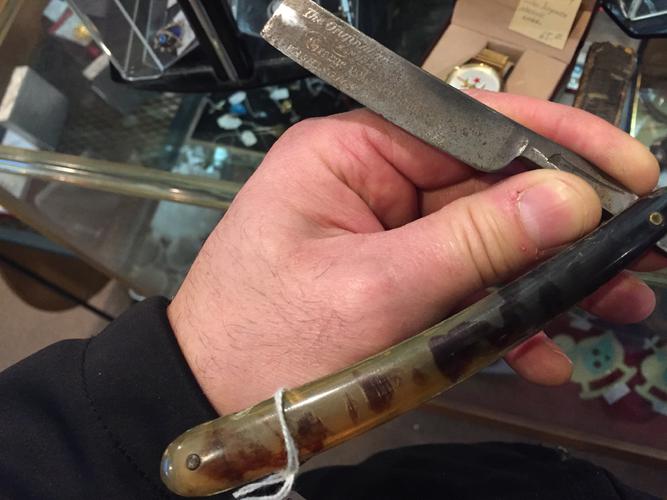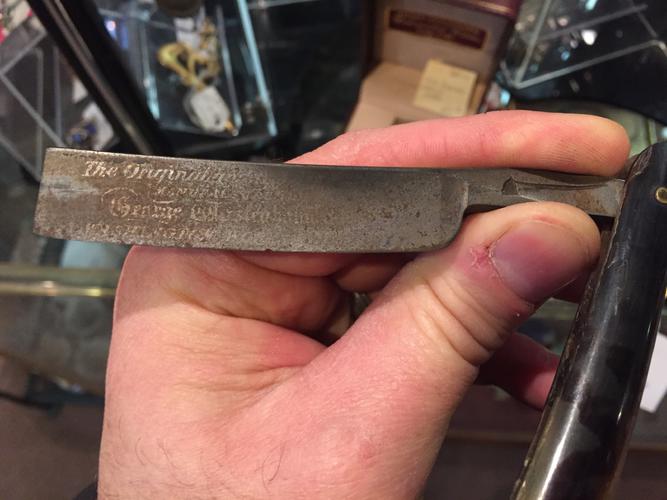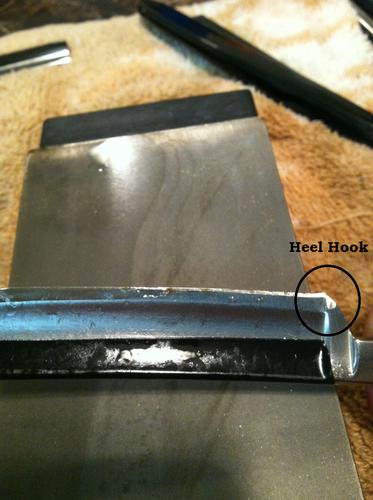Results 1 to 10 of 33
Thread: george wolstenholm and sons
-
12-28-2015, 04:34 PM #1Senior Member

- Join Date
- Oct 2015
- Location
- Pittsburgh, PA
- Posts
- 212
Thanked: 21 george wolstenholm and sons
george wolstenholm and sons
Hello everyone. Purchased this razor at an antique store for under $20. There's a lot of dirt and grime and a minimal amount of light surface rust. Aside from that there is a small chip in the blade . It also came with the original box. The scales appear to be made of tortoise shell, but I'm hoping someone here can shed light on that for me. The scales are in decent shape for the age, but as you can see in the picture there are a few chips in it. I know I took a bit of a risk when I purchased this razor, but I also know that it's an old razor and might be of value. I'm not asking for an appraisal as I know that goes against forum rules. But I would like to know your opinion if it is worth restoring and bread knifing the razor to bring back a shaving edge.


-
12-28-2015, 04:44 PM #2illegitimum non carborundum



- Join Date
- Jan 2008
- Location
- Rochester, MN
- Posts
- 11,552
- Blog Entries
- 1
Thanked: 3795
Sure anything is worth a shot if you want it as a learning opportunity. This is going to be a lot of work given the damage to the edge and the corrosion. Odds are good that the scales are off-gassing, considering the corrosion on the blade so they probably should be replaced. Breadknifing of this smiling blade should NOT be done like a knife cutting bread. That is, it should not be done with the blade held perpendicular to the hone as that will produce a straight edge no longer parallel with the smiling spine.
-
12-28-2015, 04:50 PM #3

You'll find that 99.99% of Everything pertaining to straight razors is Personal Preference.
How much do you know about honing? Bread-knifing is a drastic restoration process and if not done properly will ruin the razor.
Personally I'd work on removing the chips first and see what I have before worrying about the rest of the clean up. If you can't get a good edge then you are wasting your time cleaning up the blade.
With that said: From the looks of those chips you'll be getting into the stabilizer which can be dealt but it takes skill.
There can be things lurking underneath, and it's going to depend on how 'cleaned up' you want the razor. I don't mind some battle scars showing.
I hope that you find that it will take a nice edge and will cleanup to your expectations. Our house is as Neil left it- an Aladdins cave of 'stuff'.
Our house is as Neil left it- an Aladdins cave of 'stuff'.
Kim X
-
12-28-2015, 05:20 PM #4Historically Inquisitive



- Join Date
- Aug 2011
- Location
- Upstate New York
- Posts
- 5,782
- Blog Entries
- 1
Thanked: 4249
You got some good advise already, by the picture provided it looks to me that the scales are stained horn, a common practice to make them look like tortoise shell. The scales restoration will be much easier then the blade, JMHO.
-
12-28-2015, 05:29 PM #5Senior Member

- Join Date
- Oct 2015
- Location
- Pittsburgh, PA
- Posts
- 212
Thanked: 21
I've never bread knifed a razor before. I've honed two razors to a comfortable shave. So I'm very inexperienced. Which is why I would potentially look at having someone restore the razor for me to include a bread knife, only if the razor would be worth more (perhaps to a collector for example).
I'll have to see what vids I can find on honing a wedge shape razor as this will be new to me. I've only honed hollow ground razors so far. I'll clean up the gunk and rust, then see about what I can do with the chip in the edge of the razor.
-
12-28-2015, 05:55 PM #6

Please read Glen's warning at the start of this series.
When he's talking about a 'heel hook' here's a good picture of one:
 Our house is as Neil left it- an Aladdins cave of 'stuff'.
Our house is as Neil left it- an Aladdins cave of 'stuff'.
Kim X
-
01-14-2016, 12:49 AM #7Junior Member

- Join Date
- May 2015
- Posts
- 4
Thanked: 1
I have only had to breadknife razors with severly (1/16") frowned edges. I just use a good coarse stone. All the pipe razors that I have seen, like yours, have a slight upturn at the toe end of the edge that is pretty useful for keeping the corner off your skin when whipping around your face and I would recommend maintaining that upturn if you can. It is one of the several features that I love about my pipe razors.
-
01-14-2016, 01:16 AM #8Senior Member

- Join Date
- Oct 2015
- Location
- Pittsburgh, PA
- Posts
- 212
Thanked: 21
I've had a difficult time putting a shaving edge on this knife. Went thru my normal progression as I would with most razors. The hollow ground razors seem much easier to put a shaving edge on them. This razor is a near-wedge I think.
I've tried setting the bevel with one layer of tape, going through 1k, then 4k and 8k Norton. But I just can't seem to get it sharp at all.
So I tried adding another layer of tape, hoping to make the bevel more acute I guess. But that didn't work either. I must be doing something wrong...
-
01-14-2016, 03:57 AM #9

I would not recommend sending that out for restoration because it's going to cost more then the final product will be worth. That's a good candidate for a first restoration though if you want to go that direction. The scales look like dyed horn so you shouldnt have to worry about off-gassing. As far as honing it, you probably don't have a good bevel set. If that's a wedge you will probably need to put a good amount of effort into removing that chip and setting the bevel. There is no point in going through your stone progression until the bevel is fully set. Be sure to use tape while working on the bevel or it could cause a lot of spine wear.
-
01-14-2016, 10:55 AM #10Senior Member

- Join Date
- Oct 2015
- Location
- Pittsburgh, PA
- Posts
- 212
Thanked: 21
I've taken care of the chip already. The steel seems quite soft, and I tried a bread knifing technique that worked well. This is not a true wedge razor. Like I said above, probably a near wedge or quarter hollow. Is one layer of tape all that is required?
It just seemed like I was on my 1k King stone forever when trying to hone this razor. As If I would never get a proper bevel set. On my hollow ground razors, it's pretty clear to me when the bevel is set - I can feel it. On this razor, it LOOKS like the bevel is set, but the edge seems dull. It's weird. Maybe I just need to stay on the 1K longer? Try very very light strokes to hone that edge? I don't know. Maybe a question I should post in the honing forums...


 4Likes
4Likes LinkBack URL
LinkBack URL About LinkBacks
About LinkBacks






 Reply With Quote
Reply With Quote

